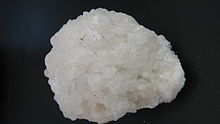| Bischofite | |
|---|---|
 Bischofite from Antofagasta, Chile | |
| General | |
| Category | Halide mineral |
| Formula (repeating unit) | MgCl2·6H2O |
| IMA symbol | Bsf[1] |
| Strunz classification | 3.BB.15 |
| Dana classification | 09.02.09.01 |
| Crystal system | Monoclinic |
| Crystal class | Prismatic (2/m) (same H-M symbol) |
| Space group | C2/m |
| Identification | |
| Color | Colorless to white |
| Crystal habit | Fibrous to massive |
| Twinning | polysynthetic |
| Cleavage | None |
| Fracture | Conchoidal to uneven |
| Mohs scale hardness | 1.5–2 |
| Luster | Vitreous – greasy |
| Streak | White |
| Diaphaneity | Translucent to transparent |
| Specific gravity | 1.56 |
| Optical properties | Biaxial (+) |
| Refractive index | nα = 1.495 nβ = 1.507 nγ = 1.528 |
| Solubility | Deliquescent |
| References | [2][3][4] |
Bischofite is a hydrous magnesium chloride mineral with formula MgCl2·6H2O. It belongs to halides and is a sea salt concentrate. It contains many macro- and micro-elements vital for human health, in much higher concentrations than can be found in sea or ocean salt. The main bischofite compound is magnesium chloride (up to 350 g/L), moreover, it contains about 70 other elements as impurities, including potassium, sodium, bromine, boron, calcium, silicon, molybdenum, silver, zinc, iron and copper.
- ^ Warr, L.N. (2021). "IMA–CNMNC approved mineral symbols". Mineralogical Magazine. 85 (3): 291–320. Bibcode:2021MinM...85..291W. doi:10.1180/mgm.2021.43. S2CID 235729616.
- ^ Webmineral data
- ^ Handbook of Mineralogy
- ^ Bischofite on Mindat